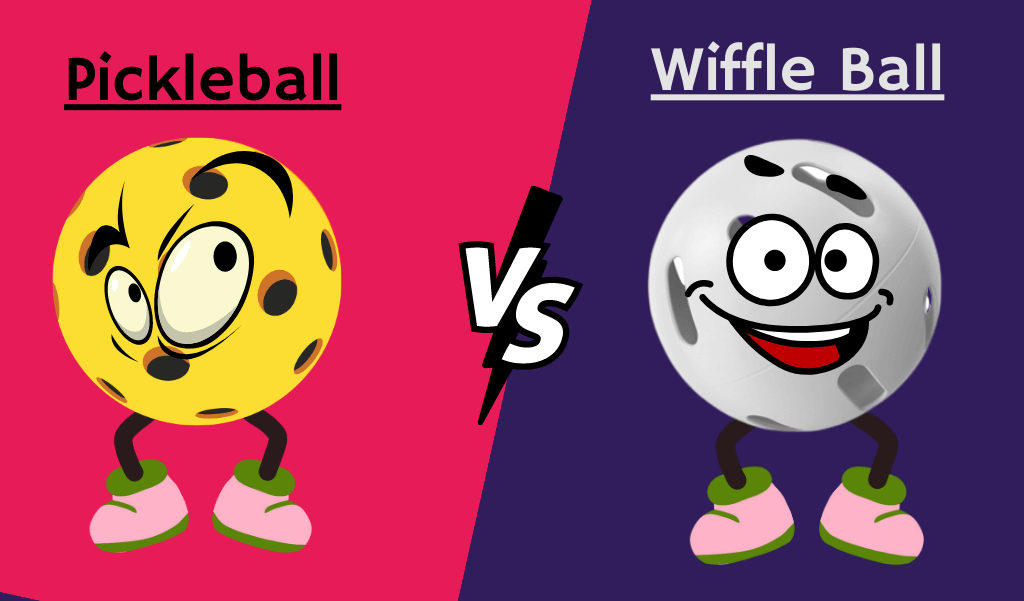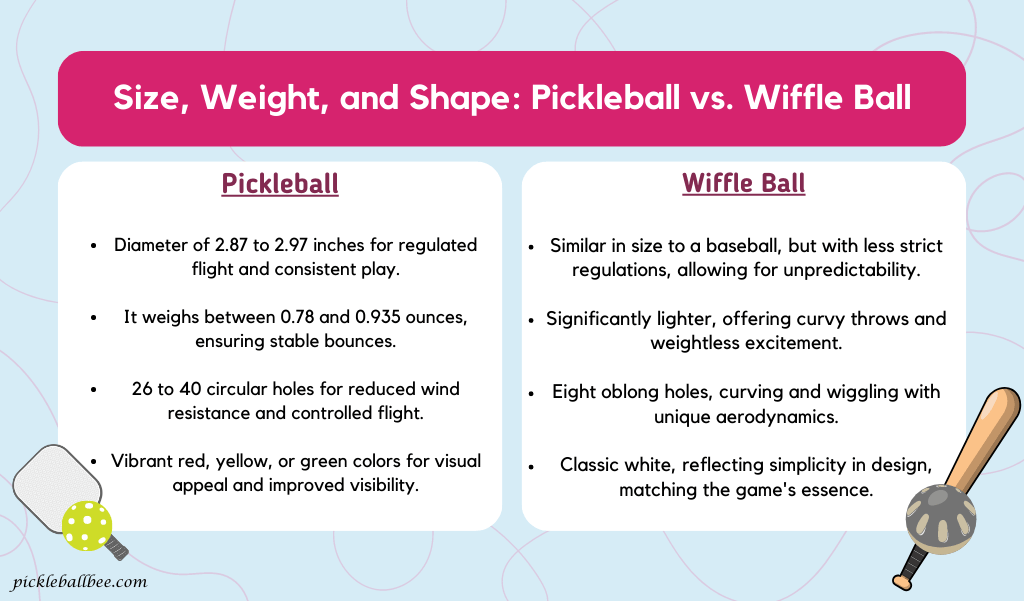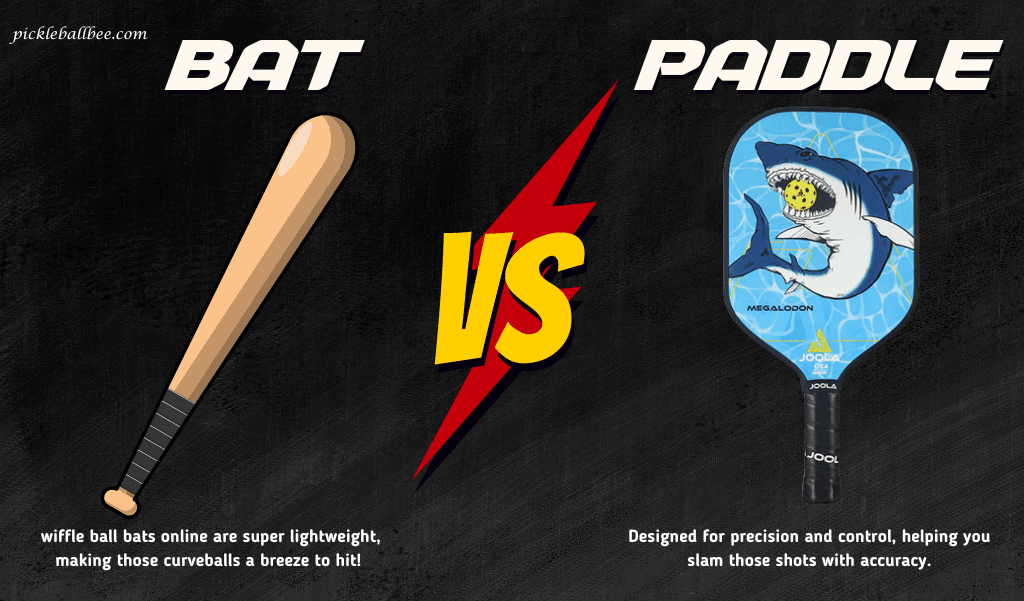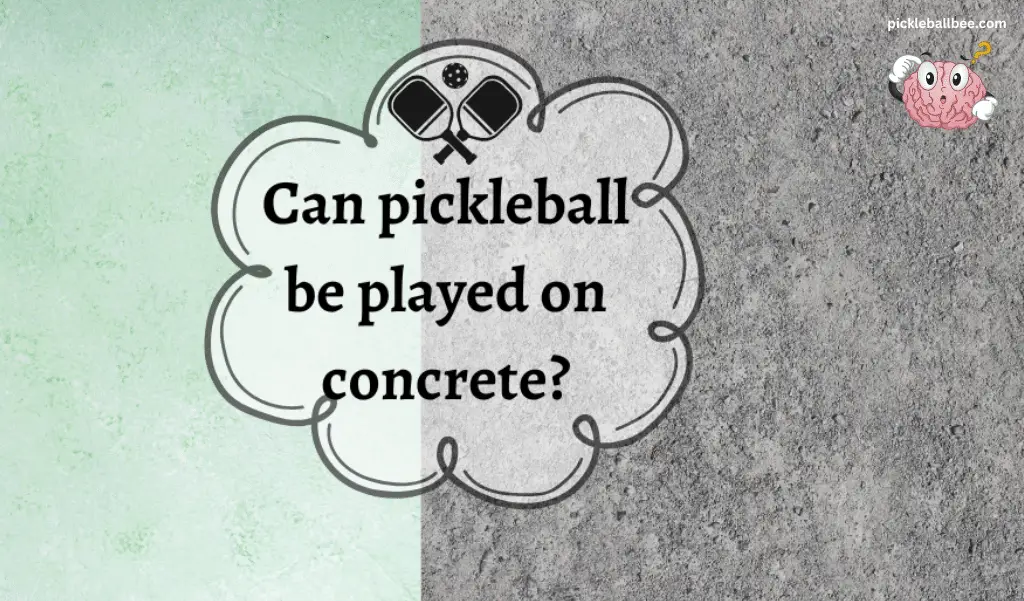“Pickleball vs. Wiffle Ball: Which game serves up more fun? Discover the differences and choose your perfect playtime!” They might look similar but are as different as chalk and cheese. Let’s dive into the nitty-gritty!

The call of the backyard often rings with the joyous clash of pickleball paddles and the whimsical thwack of Wiffle bats. Both pickleball and wiffleball are fantastic outdoor activities, yet each has its specialties. While one enchants with its fast-paced agility, the other delights with its unpredictable curves. Join us as we investigate these two games that fill our yards with laughter, cheers, and unending joy.
What is the Difference Between a Pickleball and a Wiffle Ball?
Though they may look similar, pickleball and wiffleball are worlds apart. Pickleball balls usually have 26 to 40 circular holes and come in vibrant colors. They’re designed to keep a straight trajectory during play. Wiffle balls Feature eight oblong holes, each 0.75 inches (19 mm), on one half; the other half remains hole-free.
Weight, size, and bounce are all different. While pickleball balls are controlled, waffle balls embrace unpredictability. Each game’s particular appeal and challenges are defined by the balls used. They’re like two siblings, similar in appearance but each with an individual personality!
Size, Weight, and Shape: Pickleball vs. Wiffle Ball

When you place a pickleball and a wiffleball side by side, they may seem like close cousins. But go a bit further, and you’ll discover a fascinating universe of contrasts that set them apart in their respective games.
Size: Pickleball vs. Wiffleball
Pickleball balls must adhere to a specific size, with a diameter ranging from 2.87 to 2.97 inches. This site is intended to provide a regulated flight and consistency at all levels of play.
Wiffle balls are roughly the same size as a standard baseball, but the similarities end there. The size is less strictly regulated, allowing for variations that create more unpredictability in flight.
Weight: Pickleball vs. Wiffleball
Weight is a defining feature where these two balls differ drastically. Pickleball balls must weigh between 0.78 and 0.935 ounces. The weight increases stability and a steady bounce throughout the play, which is critical for the game’s integrity.
Wiffle balls are significantly lighter and hollowed. Because they are lightweight, they can curve and dip, making every throw a surprise. The weightlessness fosters free-spirited play, and the unpredictable nature of the game adds to the excitement.
Shape and Holes:
These balls’ shape and number of holes add another layer of complexity. Pickleball balls have 26 to 40 evenly distributed, circular holes. These holes reduce wind resistance, allowing for a smoother, more controlled flight.
The Wiffle Ball matches a regulation baseball’s size but is hollow, lightweight, and made of sturdy plastic, not exceeding 1/8 inch (3.2 mm) in thickness. It features eight oblong holes, each 0.75 inches (19 mm), on one half; the other half remains hole-free.
Color and aesthetics:
Pickleball balls often come in eye-catching colors like red, yellow, or green. These colors not only add visual appeal but also improve visibility during play.
Wiffle balls, in contrast, are usually white, mimicking the traditional baseball look. The simplicity of their design complements the game’s simplicity.
Design Differences: The Art Behind the Game
Though they might look like distant relatives, pickleball and wiffleball are designed for different games, here’s what sets them apart:
Pickleball Balls:
Pickleball balls are carefully engineered to meet specific standards. They must weigh between 0.78 and 0.935 ounces and have a diameter between 2.87 and 2.97 inches. The holes are evenly distributed and circular, offering controlled aerodynamics. These design features provide a balanced, predictable play crucial to the game’s competitive nature. Even the colors are chosen to ensure optimal visibility. It’s a precise science tailored to meet the demands of a strategic sport.
Wiffle Balls:
Wiffle balls, in comparison, are the wild children of the ball family. They’re hollow and lightweight, and their holes are often oblong and located only on one side. This unique design allows the waffle ball to curve, dip, and dance in the air. It’s an art form that adds an unpredictable twist to every pitch. The design encourages a playful, free-spirited game where every throw is an adventure waiting to unfold.
Different Varieties:
Wiffle balls come in diverse types: balls without holes, with holes on both sides, training balls, and curve balls. Pickleball balls vary in weight, size, aerodynamics, and number of holes. Such a range offers a tailored playing experience, enhancing the fun!
Why different holes?
The varying holes in pickleball and wiffle balls aren’t just a whimsical design choice; they’re a fascinating blend of science and creativity. Pickleball balls have evenly spaced, circular holes designed to reduce wind resistance, allowing a smooth and controlled flight. It’s all about precision and predictability, reflecting the tactical nature of pickleball.
Wiffle balls, on the other hand, often have oblong holes positioned to catch the air differently. This unique design makes the ball curve and wiggles unpredictably, adding excitement and challenge to each throw. It’s an artistic expression that celebrates the fun and free spirit of wiffle ball.
The difference in the number of holes is not merely a design quirk; it is the soul of each game, determining how it is played, appreciated, and loved. It is a lovely reminder that even minor details can make a difference!
Materials and durability:
Both balls contain low-density polyethylene (LDPE), but outdoor pickleball balls pack a weightier punch. Wiffle balls flaunt an eight-hole design on the top half and are generally white. Both balls withstand at least ten games, but wiffle balls break quicker. They’re the rebels of the backyard!
Bounce Attributes
The bounce in pickleball is unique; both the serve and the return must bounce. Wiffle balls, with their unique 8-hole shape, specialize in unpredictability. It’s a wild ride!
Paddle vs. Bat: Tools of the Trade

In pickleball, players wield paddles made of wood or advanced composites. These paddles are designed for control, precision, and power, aligning with the game’s strategic play. They extend the player’s arm, making every swing a calculated move.
Wiffle ball, on the other hand, employs a long, plastic bat, often yellow. It’s lightweight and designed for fun, allowing for sweeping swings and surprising curves. It’s a tool that encourages a carefree, playful game.
These differences in equipment are not merely functional but echo the contrasting philosophies of two engaging backyard sports.
5 Key Differences:
Sports enthusiasts gather ’round! We’re diving into the exciting world of Pickleball and Wiffle Ball. These two games might seem similar at first glance, but don’t be fooled—crucial differences set them apart like night and day.
1. Equipment Variety: Pickleball gets going with paddles and a perforated ball on a court with a low net. On the other hand, Wiffle Ball goes for a lightweight plastic ball and a bat, often played in backyards or open spaces.
2. Court Dimensions: Here’s where things get interesting. A Pickleball court is about one-third the size of a tennis court, making it perfect for those quick, snappy rallies. Conversely, a Wiffle Ball court doesn’t have strict dimensions. It’s adaptable, fitting into various spaces, giving you room to play wherever you please.
3. Intensity and Speed: Picture this: Pickleball offers a mix of strategy and agility with just the right amount of pace. Meanwhile, Wiffle Ball takes things more leisurely. It’s all about laid-back fun with a sprinkle of unpredictability that keeps you on your toes.
4. Player Count and Dynamics: Pickleball is about coordination and quick movements, with four players for doubles or two for singles. On the other hand, Wiffle Ball thrives in larger groups, promoting camaraderie and creativity as players bat and field to their heart’s content.
5. Skill Emphasis: Regarding Pickleball, precision and finesse in your shots are key. It’s a game of control. Wiffle Ball throws a curveball (pun intended) with its wacky flight path. Quick reflexes and adaptability are your best friends here.
Can a wiffle ball be used for pickleball?
Wiffle balls were once used in pickleball, but as the game developed, so did its requirements. Today, pickleball calls for balls with a specific weight, size, and aerodynamics that wiffle balls lack. While you might be able to play with a wiffle ball, the game would lose its essence. Using a whiffle ball for pickleball would be like putting square pegs in round holes; it wouldn’t fit!
Which Sport is Similar to Wiffle Ball?
Wiffle ball is like baseball’s carefree younger sibling. It shares baseball’s core principles but brings a unique twist with its lightweight, hollow balls designed to curve. The game has been simplified so that participants of all ages and abilities can enjoy it.
It is a way to experience the excitement of baseball without requiring specialized equipment or skill. The free spirit of the sporting world makes it so charming!
Why is it called a Wiffle Ball?
The whimsical name “Wiffle” is derived from the baseball slang term “whiff,” which indicates a swing and a miss. With its unique design, a wiffle ball creates unpredictable curves that lead to many misses or “whiffs.” It’s a name that captures the fun and unpredictability of the game. Every swing is a mystery; every miss a burst of laughter, and every game a cherished memory. It is a name that perfectly captures the essence of the game!
Conclusion
Pickleball and wiffleball, though sharing a superficial resemblance, are uniquely captivating in their rights. Pickleball offers a strategic, controlled experience defined by precision, size, weight, and the engineering behind it. Wiffle ball, conversely, embraces whimsy, freedom, and the thrill of the unexpected, from its wild curves to its playful design. Both games enrich our backyards with distinctive characters, filling the air with cheers, laughter, and endless amusement. Whether you’re drawn to pickleball’s tactical rigor or wiffleball’s lighthearted playfulness, there’s a world of joy waiting for these two backyard champions. So grab your paddle or bat, call your friends and family, and make the most of these fantastic games. It’s time to play!
FAQs:
1. What three sports is pickleball most similar to?
Pickleball is often considered a blend of three popular sports: tennis, badminton, and table tennis. It incorporates elements of each, including the net from tennis, the court dimensions from badminton, and the paddle style from table tennis, creating a unique and engaging game.
2. Why is pickleball so popular?
Is pickleball popular? You bet! Anyone can play it, regardless of age or ability level. It’s fantastic for having fun with family or friends. You can play for fun or to win, and the rules are straightforward. It involves a combination of playing, thinking, and socializing. Because of this, people adore it so much!
3. What does pickleball stand for?
Pickleball doesn’t have an acronym or specific meaning behind its name. Where did the name come from? Well, it’s a bit of a puzzle! Some people think it’s named after a dog called Pickles. Others say it’s from “pickle boat,” a rowing term. But no one knows for sure. We know that the name’s now all about this fun sport. Neat, huh?


